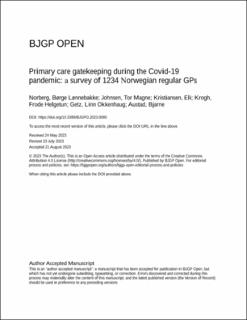| dc.contributor.author | Norberg, Børge Lønnebakke | |
| dc.contributor.author | Johnsen, Tor Magne | |
| dc.contributor.author | Kristiansen, Eli | |
| dc.contributor.author | Krogh, Frode Helgetun | |
| dc.contributor.author | Getz, Linn Okkenhaug | |
| dc.contributor.author | Austad, Bjarne | |
| dc.date.accessioned | 2024-03-05T12:05:23Z | |
| dc.date.available | 2024-03-05T12:05:23Z | |
| dc.date.created | 2023-12-19T13:41:29Z | |
| dc.date.issued | 2023 | |
| dc.identifier.issn | 2398-3795 | |
| dc.identifier.uri | https://hdl.handle.net/11250/3121087 | |
| dc.description.abstract | Background In the Nordic healthcare systems, general practitioners (GPs) regulate access to secondary health services as gatekeepers. Limited knowledge exists about the gatekeeper role of GPs during public health crises seen from the GPs’ perspective.
Aim To document GPs’ gatekeeper role and organisational changes during the initial Covid-19 lockdown in Norway.
Design & setting A cross-sectional online survey was addressed to all regular Norwegian GPs (n = 4858) during pandemic lockdown in spring 2020.
Method Each GP documented how patients with potential Covid-19 disease were triaged and handled during a full regular workday. The survey also covered workload, organisational changes and views on advice given by the authorities.
Results A total of 1,234 (25%) of Norway’s GPs participated. Together, they documented nearly 18,000 consultations, of which 65% were performed digitally (video, text, and telephone). Suspected Covid-19 symptoms were reported in 11% of the consultations. Nearly all these patients were managed in primary care, either in regular GP offices (56%) or GP-run municipal respiratory clinics (41%), while 3.7% (n=73) were admitted to hospitals. The GPs proactively contacted an average of 0.8 at-risk patients per day. While 84% were satisfied with the information provided by the medical authorities, only 20% were able to reorganise their practice in accordance with national recommendations.
Conclusion During the early stage of the Covid-19 pandemic in Norway, the vast majority of patients with Covid-19-suspected symptoms were handled in primary care. This is likely to have protected secondary health services from potentially detrimental exposure to contagion and breakdown of capacity limits. | en_US |
| dc.language.iso | eng | en_US |
| dc.publisher | Royal College of General Practitioners | en_US |
| dc.relation.uri | https://pubmed.ncbi.nlm.nih.gov/37907336/ | |
| dc.rights | Navngivelse 4.0 Internasjonal | * |
| dc.rights.uri | http://creativecommons.org/licenses/by/4.0/deed.no | * |
| dc.title | Primary care gatekeeping during the Covid-19 pandemic: a survey of 1234 Norwegian regular GPs | en_US |
| dc.title.alternative | Primary care gatekeeping during the Covid-19 pandemic: a survey of 1234 Norwegian regular GPs | en_US |
| dc.type | Peer reviewed | en_US |
| dc.type | Journal article | en_US |
| dc.description.version | publishedVersion | en_US |
| dc.source.journal | British Journal of General Practice Open | en_US |
| dc.identifier.doi | 10.3399/BJGPO.2023.0095 | |
| dc.identifier.cristin | 2215621 | |
| cristin.ispublished | true | |
| cristin.fulltext | original | |
| cristin.qualitycode | 1 | |

